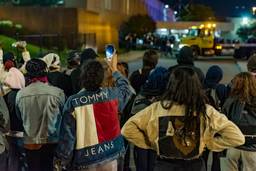Why We Still Need a Movement to Keep Youth From Joining the Military
A scrappy counter-recruitment movement is trying to starve the military of labor.
Elizabeth King

Eighteen is the youngest age at which someone can join the U.S. military without their parents’ permission, yet the military markets itself to — which is to say recruits — children at much younger ages. This is in part accomplished by military recruiters who visit high schools around the country, recruiting children during career fairs and often setting up recruitment tables in cafeterias and hallways. As a result, most students in the U.S. will meet a military recruiter for the first time at just 17 years old, and children are getting exposed to military propaganda younger and younger.
The recruitment of young people to the military is as old as the military itself, and has become more and more normalized along with the general militarization of schools. According to the Urban Institute, more than two-thirds of public high school students attend schools where there are “school resource officers,” a name for school-based police. This police presences comes on top of the role of military recruiters on campuses, or at college and career fairs.
Counter-recruitment surged in popularity during George W. Bush’s Iraq War, when the U.S. military ratcheted up recruitment for the war. But these days you don’t hear much about this movement, despite the fact that the U.S. is still engaged in brutal wars, from Yemen to Afghanistan, and the Trump administration has been threatening war with Iran. Out of the spotlight, dedicated counter-recruiters around the country are steadfast in their organizing to cut off the human supply chain to the U.S. military. U.S. wars have caused innumerable deaths, created long-term hardships in occupied nations, and cost trillions of dollars. Counter-recruitment, then, is about starving the military of the labor it needs to accomplish these destructive missions. When working with students, parents and school leadership, counter-recruiters focus on a variety of issues, including the negative personal consequences that come with being a soldier and broader problems like racism and U.S. imperialism.
Kate Connell, the director of the California counter-recruitment organization Truth in Recruitment, a parent, and a Quaker, tells In These Times that one reason counter-recruitment efforts are so overlooked these days is that U.S. casualties in Iraq and Afghanistan have fallen out of the news. “I think that’s kind of what got people concerned and out in the streets” in the past, she says. Though this movement doesn’t get as much attention these days, organizers and activists say that counter-recruitment efforts remain critically important.
For the most part, activists who do counter-recruitment work in schools focus on matching or exceeding military recruiters in face-time with kids. Thanks to the No Child Left Behind Act, military recruiters are required to have the same level of access to students as college and career professionals who recruit in schools.
Hart Viges, a U.S. Army veteran who has been volunteering in counter-recruitment for around a decade and works with Sustainable Options for Youth-Austin (SOY-Austin), says his role is to educate children using interactive tabling in schools. The group brings t-shirts and a “peace wheel” the students can spin to learn more facts about the military. Children also get to discuss how they’d like taxpayer dollars spent. For example, they might discuss whether they want to spend billions on war, or allocate that money elsewhere. Viges is blunt with them about what life will be like after time spent in the military.
“I ask them, ‘Do you like fireworks?’” Viges says. When they respond yes, he explains, “you won’t like them anymore” after coming back from a war. He tells them the realities of living with post-traumatic stress disorder brought about by combat, and how it does lasting damage to veterans. Being real with children about the military has proven effective for Viges. “There’s so many wins in counter recruitment I feel,” he adds. “I talk to kids who are thinking about joining and I tell them the realities of it, and you can see their minds start to change… With politicians it’s like a stalemate, but counter-recruitment is like a punch in the gut that will topple the military industrial complex.” Hart also talks to children about other issues connected to the military industrial complex that concerns them, such as war in general, racism, sexism and climate change.
Youth are active in this work, too. Jenny, a 16-year-old incoming junior at Santa Maria High School in California, interns with Truth in Recruitment. She tells In These Times that she got involved with the organization after a friend told her it would be a good way to stand up for herself and her peers who are frequently visited by military recruiters at school.
When she started high school, Jenny says she noticed that the military recruiters frequented her school, but other opportunities for students post-high school were not well represented. “I thought this was a problem, especially since the majority of us are students of color and I thought that we were being disproportionately targeted because we are people of color,” she says.
Angel further notes that many students at her school are undocumented, and she noticed that military recruiters were telling her peers distorted information about the benefits of military service based on their undocumented status. She says that after speaking to military recruiters, a number of her peers have said that they were promised they would get U.S. citizenship if they served in the military. While there is some pathway for non-citizens who serve in the military to become naturalized, this is not a guaranteed benefit. In fact, the U.S. government has a history of deporting foreign nationals who were employed by the military. “I always have to correct them because I don’t want them to join and not know the full truth about it,” Angel says. “We wouldn’t be seeing these things at schools rich, white students attend.”
The military does, in fact, tend to recruit in poor and working class communities, especially among Black and Latinx youth. The strategy of targeting poor, working-class, and Black and Latinx people for military conscription is known as the “poverty draft.” The tactics of this strategy can be seen in military recruitment efforts at schools like Santa Maria High School where Angel attends, and is evident in studies on the socioeconomic status of people who fought in recent US wars. According to a 2016 study out of Boston University and the University of Minnesota Law School, “Today, unlike in World War II, the Americans who die or are wounded in war are disproportionately coming from poorer parts of the country.”
Connell, the Truth in Recruitment director, says that the tactics used by military recruiters on children are “very much a grooming process.” She notes that branches of the military operate social media accounts, where they will follow and communicate with students who are potentially interested in joining up. In this way, recruiters have direct, unsupervised access to young teens, who may or not be discussing recruitment efforts with trusted adults in their lives. This type of behavior, Connell says, is “inappropriate.”
Still, the presence of the military in schools has become normalized. “I feel that the idea that the military is an untouchable subject as far as criticism or cutting the budget, [makes counter-recruitment] a really tricky conversation to have, so people avoid it.” The institutional power and not to mention funding and broad support that the military has makes counter-recruitment a challenge.
But the group has seen concrete results from their organizing and advocacy. Working with students, parents, and school and district leadership in Santa Barbara in 2014, Truth in Recruitment was able to convince the district to create better resources for parents to more easily opt their students out of having their information shared with military recruiters.
Though counter-recruitment is perhaps not as prominent as it was more than a decade ago, organizers in this field are unequivocal about the need to support students by offering alternatives to the military, such as college or the workforce. As the military continues to target children, especially in low-income and Black and Latinx communities, counter-recruiters will continue to work with children and their care-takers to offer safer, more dignified options for life after high school.







